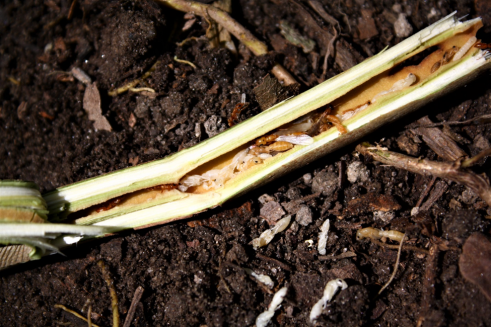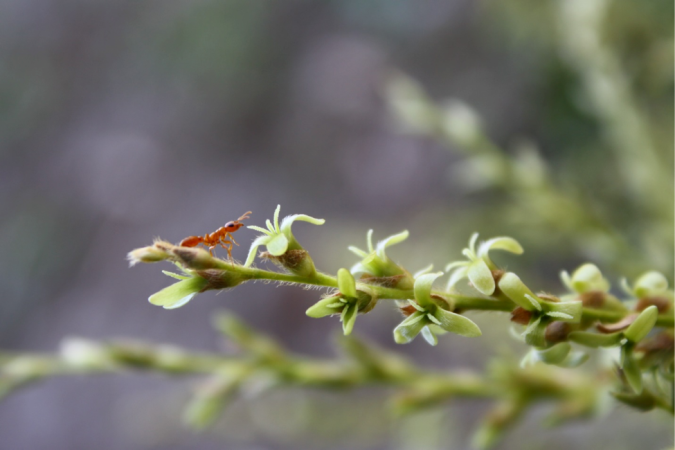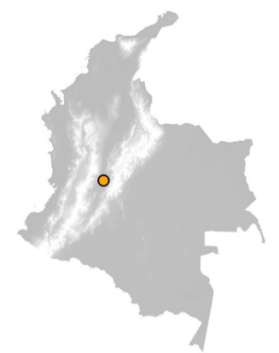A blog post highlighting the article by Insectes Sociaux
By Fernanda Torres
Perhaps one of the most astonishing features of ants is their ability to establish mutualistic associations with plants, myrmecophyte plants in particular. About 110 ant species nest exclusively inside hollow structures in leaves, stems or roots the host plant produces (Chomicki and Renner 2015). The mutualism is beneficial for the ants because the host plant provides the colony with housing and food. This food can be obtained directly from the plant or honeydew secreted from the ant-tended hemipterans living on the plant. For the plant, hosting an ant colony is comparable to having its own defense army for a lower cost than producing extensive chemical defenses.
For both members of a mutualism, identifying and locating (or attracting) the right partner is a crucial step in the establishment of the mutualism. Fertile founding queens (alates) emerge from the colony and, after the nuptial flight, they start their quest for a host for her new colony. Finding a place as fast as possible contributes to the survival of the both queens and host plants. For the ant queen, flying towards the wrong plant species or finding a colony already occupying a host translates into wasted energy and increased competition.

Alate P. mordax queens running away from the researchers after a branch was cut open. Photo: M.F. Torres
So, how do plants advertise available spaces to the founding queens, especially when host plants are dispersed over large areas? What signals are queens recognising? Communication between plants and ants is mostly mediated by volatile chemical compounds (Heil and McKey 2003; Edwards et al. 2006). In our study, we wanted to test if the plant chemical signals that attract ant queens vary depending on the plant’s developmental stage and if queens respond to such variation. Every new generation of founding queens must be capable of distinguishing the most suitable available host from a pool of hundreds of other plants across large distances. It is a question of survival for both ants and hosts, requiring that the mechanisms of recognition and attraction are precise and informative to be successful.
To help us understand ant-plant communication, we studied Pseudomyrmex mordax queens to test their preferences between young and mature leaves or seedling and adult Triplaris americana plants. Pseudomyrmex is a genus of ants restricted to the Neotropics. Some species of the aggressive Pseudomyrmex nest inside myrmecophyte plants like Acacia, Cordia, Tachigali, and Triplaris, (Ward 1991, 1999) and tend coccids (Hemiptera) to obtain sugar. To survive, P. mordax must form a mutualism with T. americana and it is such a good guardian that has made Triplaris earn the name of “vara santa” (or holy rod) as the colony members will painfully sting however comes into the plant’s proximity.

P. mordax worker patrolling T. americana flowers. Photo: M.F. Torres

Location of Guamo, Tolima-Colombia, where we performed the experiments.
For the experiments, we collected young and mature leaves from both seedling and adult T. americana trees from a population in Colombia. We also collected alate P. mordax queens from the branches of nearby T. americana trees that were not used for the experiment (as we were subject of the ants’ aggressiveness). In an experiment conducted in the field, we placed the leaves of the young and mature T. americana on opposite sides of a two-sided olfactometer and recorded the time each queen spent on each side. We also performed the experiment leaving one of the sides empty as a control. We then compared the differences between the time on each side across all the queens used in the experiment to establish whether the young ant queens had a significant preference for a particular leaf age or plant age.
We found that while queens do not show a preference for young and mature leaves from the same plant, they do prefer leaves from T. americana seedlings over adults. Queens also spent more time in the arm of the olfactometer containing T. americana leaves when the other arm was left empty. Our findings show that P. mordax queens are attracted by volatile chemical compounds produced by T. americana and discriminate signals produced by its seedlings from other signals. The ability to distinguish between plant development stages, along with the use of chemical cues to find a mutualist plant partner increases the chances of a queen’s survival. For the seedling, the ant queen and her future colony provide early protection against herbivores and competition by pruning competing plants, enhancing seedling survivorship. Knowing the age of plant that the queens prefer is only one part of the story. Comparing the relative abundance of the chemical volatiles from each type of leaf will provide more information about how the plant uses odors to signal the queen to her new home.
References
Chomicki G, Renner SS (2015) Phylogenetics and molecular clocks reveal the repeated evolution of ant‐plants after the late Miocene in Africa and the early Miocene in Australasia and the Neotropics. New Phytol 207(2):411-424
Edwards DP, Hassall M, Sutherland WJ, Yu DW (2006) Assembling a mutualism: ant symbionts locate their host plants by detecting volatile chemicals. Insect Soc 53:172–176
Heil M, McKey D (2003) Protective ant-plant interactions as model systems in ecological and evolutionary research. Annu Rev Ecol Evol S 34:425–553
Ward PS (1991) Phylogenetic analysis of Pseudomyrmecine ants associated with domatia-bearing plants. In: Huxley CR, Cutler DF (eds) Ant-plant interactions. Oxford University Press, Oxford, pp 335–352
Ward PS (1999) Systematics, biogeography and host plant associations of the Pseudomyrmex viduus group (Hymenoptera: Formicidae), Triplaris– and Tachigali-inhabiting ants. Zool J Linn Soc 126:451–540